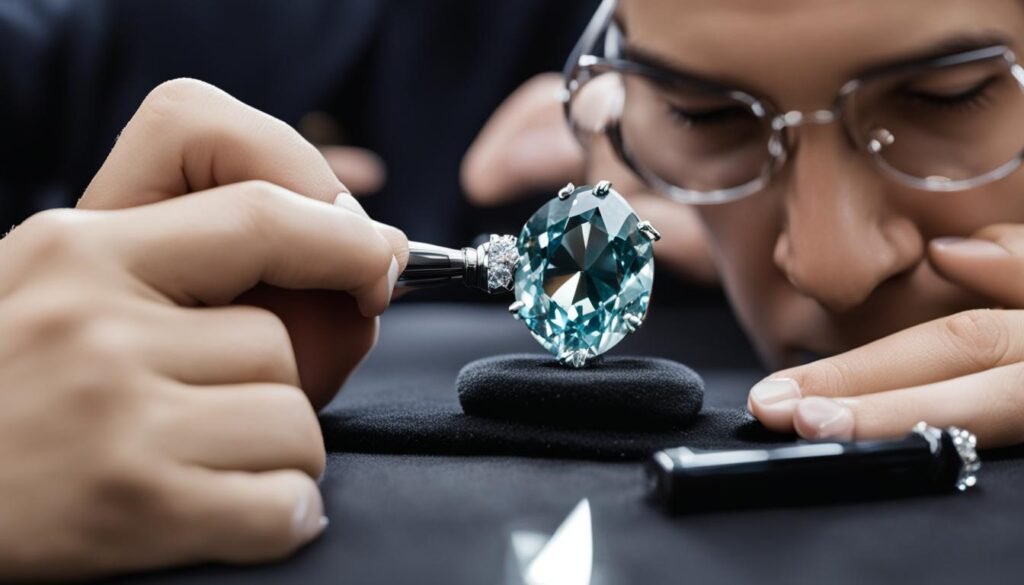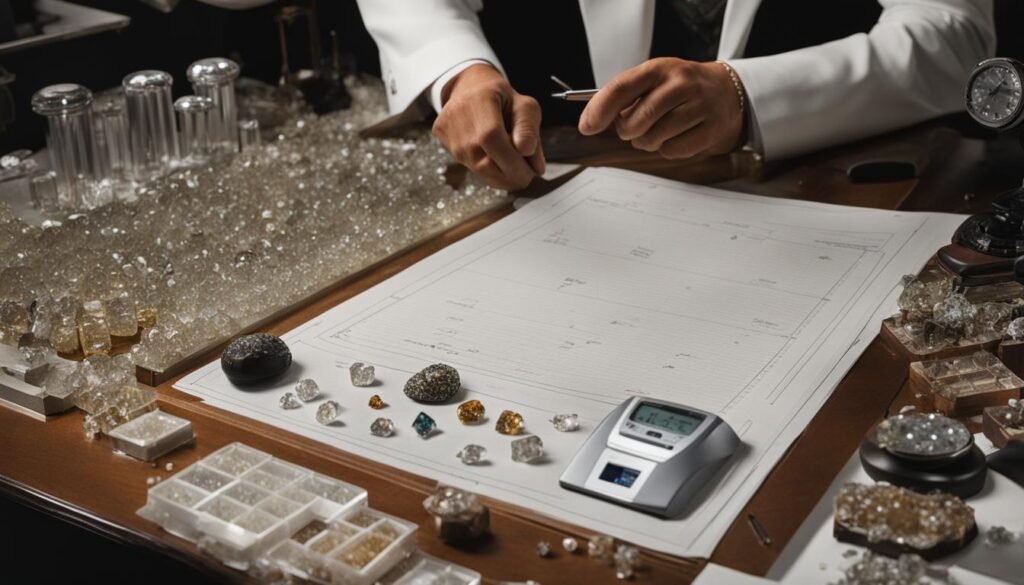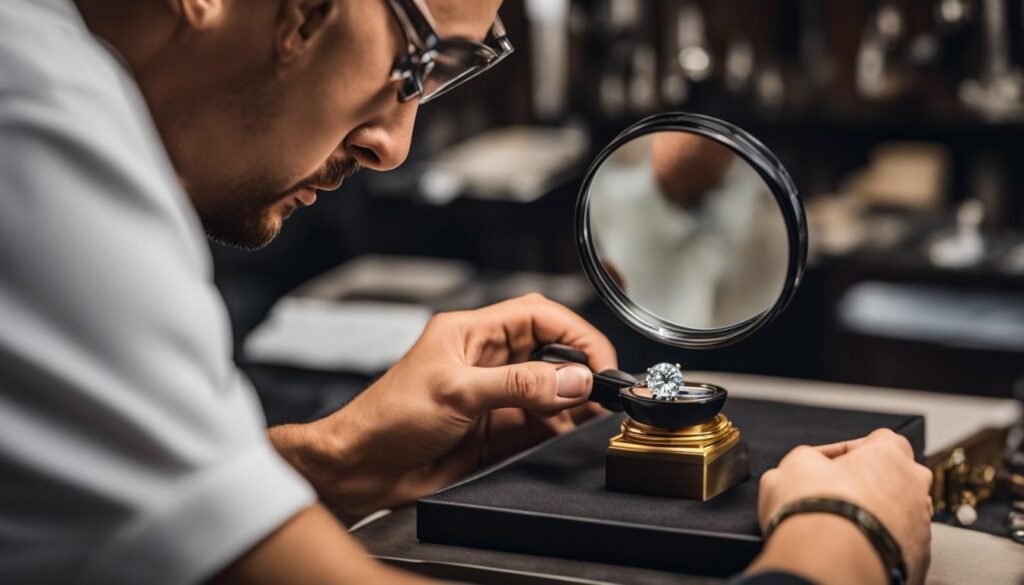Moissanite, with its striking resemblance to diamonds, often prompts the question of whether a jeweler can distinguish between the two. Jewelers, with their expertise and specialized knowledge, possess the tools and techniques to identify moissanite accurately. By understanding the characteristics of moissanite and utilizing gemological testing, visual inspection, and certification, jewelry experts can determine if a stone is a moissanite or a diamond.
- Jewelers can utilize gemological testing and visual inspection to identify moissanite.
- Moissanite closely resembles diamonds in appearance but differs in composition and properties.
- Certification from reputable sources confirms the authenticity of moissanite.
- It may be challenging for the average person to differentiate moissanite from diamonds without specialized knowledge.
- Be aware of the challenges posed by fake moissanite and purchase from reputable sellers.
The Distinction Between Moissanite and Diamonds
Moissanite and diamonds share similar visual characteristics but differ in their composition and properties. To better understand how to identify moissanite, let’s explore the distinctions between these two gemstones.
Diamonds are natural gemstones formed from carbon, while moissanite is a lab-created stone made of silicon carbide. This difference in composition gives each gemstone its unique set of characteristics.
One notable difference is the refractive index. Moissanite has a higher refractive index than diamonds, meaning it reflects light differently. This results in moissanite having greater fire and brilliance, with more colorful flashes when exposed to light. Diamonds, on the other hand, offer a classic sparkle with their lower refractive index.
Another crucial aspect to consider is the durability. Diamonds are known for their exceptional hardness and rank as a 10 on the Mohs scale. In comparison, moissanite has a rating of 9.25, making it a durable gemstone suitable for everyday wear.
Understanding these distinctions can help jewelers evaluate the characteristics of a gemstone and determine whether it is a moissanite or a diamond.
Take a look at the visual representation below for a clear overview of the main differences:
Moissanite vs Diamonds: A Comparison
| Gemstone | Composition | Refractive Index | Mohs Scale Rating |
|---|---|---|---|
| Diamond | Carbon | Lower | 10 |
| Moissanite | Silicon Carbide | Higher | 9.25 |
As shown in the table, moissanite and diamonds have distinct compositions, refractive indexes, and ratings on the Mohs scale. These differences are essential in identifying and evaluating gemstones accurately.
How Jewelers Identify Moissanite
Jewelers use various methods to identify and authenticate moissanite, ensuring customers can confidently differentiate between this lab-created gemstone and diamonds. By utilizing specialized tools, conducting visual inspections, and seeking professional expertise, jewelers can accurately identify moissanite.
Loupes, Microscopes, and Diamond Testers:
Jewelers utilize loupes and microscopes to closely examine the characteristics of gemstones. These tools allow for a detailed visual inspection, enabling jewelers to identify the unique features of moissanite. In addition, diamond testers, which measure electrical conductivity, play a crucial role in differentiating moissanite from diamonds. Moissanite’s distinct electrical properties provide a reliable indicator for jewelers during the identification process.
Double Refraction:
One notable characteristic of moissanite is its ability to exhibit double refraction. This phenomenon occurs as a result of moissanite’s higher refractive index compared to diamonds. By visually inspecting the stone and observing any double refraction, jewelers can further confirm the presence of moissanite.
Consulting Gemological Laboratories and Certified Gemologists
For more complex moissanite identification and authentication, jewelers often turn to gemological laboratories and certified gemologists. These professionals possess extensive knowledge and expertise in gemstone evaluation, utilizing advanced gemological testing methods to accurately determine if a stone is moissanite.
By combining their own expertise with the resources available through gemological laboratories and certified gemologists, jewelers can confidently identify and authenticate moissanite, ensuring customers receive accurate information and make informed purchasing decisions.

| Methods | Advantages | Limitations |
|---|---|---|
| Loupes, Microscopes | – Detailed visual inspection – Ability to identify unique characteristics of moissanite |
– Visual inspection alone may not be sufficient |
| Diamond Testers | – Measure electrical conductivity – Differentiate moissanite from diamonds based on electrical properties |
– Traditional diamond testers may yield false readings – Limited availability of moissanite testers |
| Visual Inspection | – Identify double refraction as a characteristic of moissanite | – Requires expertise and knowledge of moissanite’s unique features |
| Gemological Laboratories and Certified Gemologists | – Access to advanced gemological testing methods – Expertise in identifying moissanite – Enhanced authenticity verification |
– Additional cost and time for more complex testing |
Through a combination of expert knowledge, specialized tools, and collaborative partnerships with gemological laboratories, jewelers can confidently identify and authenticate moissanite. This ensures customers receive accurate information and can make informed decisions when purchasing moissanite jewelry.
Can the Average Person Distinguish Moissanite from Diamonds?
For the average person, identifying moissanite from diamonds can be a challenging task, especially without specialized tools or knowledge. While some visual differences may exist, such as moissanite’s greater sparkle or potential yellow or green hue, these distinctions may not be readily apparent to an untrained eye.
Unlike jewelry experts or gemologists who undergo extensive training and possess the necessary equipment, the average person may struggle to accurately identify moissanite versus diamonds. While visual inspection can provide some clues, it may not be sufficient to make a definitive determination.
The Importance of Visual Inspection
Visual inspection is one method that people rely on to distinguish between moissanite and diamonds. However, it’s essential to note that relying solely on visual cues can be unreliable. While moissanite may exhibit certain visual characteristics, such as a higher brilliance and potential coloration, these distinctions might not be easily discernible without proper expertise.
“Visual inspection alone may not be sufficient to make an accurate determination.”
Moissanite has a reputation for being an excellent diamond alternative due to its diamond-like appearance. Since moissanite closely resembles diamonds, it takes a trained eye to make an accurate identification.
Seeking Professional Guidance
In cases where the average person is unsure about the authenticity of a stone, it is advisable to consult a jeweler or gemologist with expertise in moissanite identification. These experts have the knowledge, experience, and tools necessary to conduct thorough evaluations and provide reliable assessments.
By seeking professional guidance, the average person can rely on the expertise of professionals who specialize in gemstone evaluation and moissanite identification. Jewelers and gemologists can perform comprehensive tests, including specialized gemological testing and visual inspections, to determine whether a stone is moissanite or a diamond.
Considerations for Moissanite Identification
While the average person may face challenges in distinguishing moissanite from diamonds, there are factors to consider for a more informed evaluation:
- Understanding the unique characteristics and properties of moissanite, such as its higher refractive index and distinct double refraction
- Knowing the visual differences that can potentially indicate the presence of moissanite, such as a greater sparkle or potential coloration
- Seeking the assistance of a trusted jeweler or gemologist who can provide accurate identification through professional methods and equipment
It is essential to note that moissanite, despite its similarities to diamonds, holds its own value and beauty. Whether someone chooses a moissanite or a diamond, both can be stunning gemstone options for jewelry.
| Moissanite Identification Methods | Pros | Cons |
|---|---|---|
| Visual inspection | – Can provide some visual cues – May indicate differences in sparkle and potential coloration |
– Relies on subjective interpretation – Distinctions may be difficult to identify without expertise |
| Professional evaluation | – Expert knowledge and tools – Thorough assessment through gemological testing – Accurate identification |
– Requires professional assistance |
Note: The above table highlights the pros and cons of different moissanite identification methods, emphasizing the importance of professional evaluation for accurate results.
The Limitations of Diamond Testers in Identifying Moissanite
Diamond testers play a crucial role in the identification of diamonds, relying on thermal conductivity to distinguish these precious gemstones. However, when it comes to identifying moissanite, the effectiveness of diamond testers is limited. Both moissanite and diamonds exhibit similar electrical conductivity properties, resulting in potential inaccuracies when using traditional diamond testers.
While diamond testers may give false readings, there are alternatives available for more accurate moissanite identification. Moissanite testers that specifically measure electrical conductivity can provide more reliable results. These specialized tools are designed to differentiate moissanite from diamonds based on their distinct electrical conductivity characteristics.
It is important to note that moissanite testers measuring electrical conductivity may not be widely accessible compared to traditional diamond testers. This limitation can pose challenges for individuals attempting to identify moissanite without access to specialized tools. In such cases, additional methods of identification and authentication may be necessary.
“The limitations of diamond testers in identifying moissanite emphasize the importance of comprehensive gemstone authentication methods.” – Gemstone Authentication Expert
When faced with the task of moissanite identification, it is advisable to consult professional jewelers or gemologists with expertise in gemstone authentication. These experts have the knowledge and tools to accurately determine whether a stone is moissanite or a diamond, ensuring the authenticity of the gemstone.
By understanding the limitations of diamond testers in identifying moissanite, individuals can seek alternative methods of authentication and make informed decisions when examining gemstones.

Comparing Diamond Testers and Moissanite Testers
| Factors | Diamond Testers | Moissanite Testers |
|---|---|---|
| Principle | Thermal conductivity | Electrical conductivity |
| Effectiveness in Distinguishing Moissanite | Limited | More Accurate |
| Availability | Widely Accessible | Less Accessible |
Factors to Consider When Authenticating Moissanite
To authenticate moissanite, several factors should be considered. This process involves careful evaluation and analysis of the gemstone to ensure its authenticity. Here are some key factors to keep in mind when authenticating moissanite:
Certification from Reputable Gemological Laboratories
One important factor in moissanite authentication is the certification provided by reputable gemological laboratories. These certifications serve as an assurance of the gemstone’s authenticity and help differentiate it from diamonds or other gemstones. When purchasing moissanite, look for certificates from well-established and recognized laboratories such as the Gemological Institute of America (GIA) or the International Gemological Institute (IGI).
Visual Inspection
Visual inspection plays a crucial role in the authentication process. During this examination, jewelers look for specific features and characteristics that are indicative of moissanite. These include double refraction, which causes the stone to appear blurry or with doubled lines when viewed through a gemological loupe. Clarity and color are also examined to ensure they align with the typical characteristics of moissanite.
Seeking Expertise from Qualified Jewelers and Gemologists
Authenticating moissanite can be a complex task that requires expertise and experience. Consulting a qualified jeweler or gemologist who specializes in moissanite identification is a wise choice. These professionals have a deep understanding of the gemstone’s unique characteristics and can provide a comprehensive evaluation. Their expertise can ensure accurate authentication and help you make an informed decision.
By considering these factors and engaging in thorough gemstone evaluation, you can confidently authenticate and differentiate moissanite from other gemstones, ensuring that you are purchasing genuine moissanite jewelry.
| Factors to Consider | Details |
|---|---|
| Certification from Reputable Gemological Laboratories | Certificates from recognized laboratories like GIA or IGI |
| Visual Inspection | Double refraction, clarity, and color examination |
| Seeking Expertise from Qualified Jewelers and Gemologists | Consulting specialists in moissanite identification |
The Popularity and Challenges of Moissanite in the Jewelry Market
As moissanite continues to gain popularity as an affordable alternative to diamonds, the jewelry market has seen a surge in the availability of fake moissanite stones. The striking similarities between moissanite and diamonds make it increasingly challenging for consumers to differentiate between genuine and counterfeit stones.
The growing prevalence of fake moissanite undermines consumer trust and poses significant challenges to reputable jewelers. The reputation of these jewelers can be negatively impacted if customers unknowingly purchase fake moissanite instead of genuine gemstones.
It is imperative for both consumers and the jewelry industry to be aware of the challenges posed by fake moissanite and take steps to ensure authenticity when purchasing moissanite jewelry. Gemstone evaluation becomes crucial in this scenario, enabling customers to make informed decisions and protect their investment.
While genuine moissanite offers a range of benefits, such as affordability and brilliance comparable to diamonds, the influx of counterfeit stones necessitates caution. Consumers should educate themselves about gemstone evaluation techniques, seek reputable sellers, and insist on proper certification and documentation for moissanite purchases.
In order to combat the challenges posed by fake moissanite, reputable jewelers can play a crucial role by implementing strict quality control measures. By ensuring that their inventory consists solely of genuine moissanite and providing customers with the necessary certifications and documentation, jewelers can help maintain customer trust within the jewelry market as a whole.
Overall, as the popularity of moissanite continues to rise, it is important for both consumers and jewelry professionals to remain vigilant in the face of counterfeit stones. By prioritizing gemstone evaluation and taking necessary precautions, consumers can confidently enjoy the beauty and value of moissanite jewelry.
Tips for Spotting Fake Moissanite
Spotting fake moissanite requires attention to detail and knowledge of the characteristics of genuine moissanite. By understanding key indicators, consumers can make informed decisions when evaluating the authenticity of moissanite gemstones.
Indicators of Counterfeit Moissanite
- Variations in size and weight compared to genuine stones
- Inconsistencies in clarity and color
- Presence of flaws or irregularities
Genuine moissanite stones typically have consistent size, weight, and clarity. If the stone you are examining appears significantly different in any of these aspects, it may be an indication of counterfeit moissanite.
Advanced Technological Methods
Advanced technological methods can further aid in detecting fake moissanite. Thermal conductivity testers and reflectivity tests are particularly effective in distinguishing moissanite from other gemstones.
“Thermal conductivity testers can help identify moissanite due to its unique heat dissipation properties. Additionally, reflectivity tests, which measure how light interacts with the gemstone’s surface, can reveal valuable insights into the stone’s authenticity.” – Gemologist David Robertson
Utilizing these advanced methods can provide additional verification when evaluating the genuineness of moissanite.
Source from Reputable Sellers
When purchasing moissanite jewelry, it is crucial to source from reputable sellers who provide certification and documentation to verify the authenticity of the stones. Reputable sellers will often have recognized certifications from gemological laboratories that attest to the stone’s origin and characteristics.
By following these tips, consumers can better navigate the market and confidently identify genuine moissanite gemstones.
Conclusion
Professional jewelers and gemologists possess the expertise and specialized tools necessary to accurately determine whether a stone is moissanite or a diamond. While it may be challenging for the average person to differentiate between the two, there are reliable methods that can aid in moissanite identification, such as visual inspection, certification, and gemological testing.
By understanding the distinct characteristics and properties of moissanite and diamonds, both consumers and the jewelry industry can ensure authenticity and make informed purchasing decisions. Gemstone evaluation is essential in this process, allowing individuals to confidently enjoy the beauty and value of moissanite jewelry.
Whether seeking a diamond alternative or embracing the unique qualities of moissanite, consulting with a knowledgeable jeweler or gemologist is crucial. These professionals can provide valuable guidance and expertise in moissanite identification, ensuring that individuals make the right choice based on their preferences and needs.
FAQ
Can a jeweler tell if moissanite is real?
Yes, jewelers can determine if a stone is moissanite or a diamond by using specialized tools and techniques such as certification, visual inspection, and gemological testing.
What is the distinction between moissanite and diamonds?
Moissanite is a lab-created gemstone made of silicon carbide, while diamonds are natural gemstones formed from carbon. Moissanite has a higher refractive index and greater fire and brilliance compared to diamonds.
How do jewelers identify moissanite?
Jewelers use specialized tools such as loupes, microscopes, and diamond testers to examine the characteristics of the stone. They also visually inspect the stone for double refraction and may consult gemological laboratories for more complex testing.
Can the average person distinguish moissanite from diamonds?
It can be challenging for the average person to differentiate between moissanite and diamonds without specialized tools or knowledge. Visual differences such as sparkle and color may not be apparent to an untrained eye, so relying on a jeweler or gemologist is recommended.
What are the limitations of diamond testers in identifying moissanite?
Traditional diamond testers may not be entirely reliable in distinguishing moissanite from diamonds as both gemstones have similar electrical conductivity properties. Moissanite testers that measure electrical conductivity can provide more accurate results but may not be widely available.
What factors should be considered when authenticating moissanite?
Factors to consider when authenticating moissanite include certification from reputable gemological laboratories and visual inspection for features like double refraction, clarity, and color. Consulting a qualified jeweler or gemologist can provide a comprehensive evaluation and authentication.
What are the challenges associated with moissanite in the jewelry market?
The increasing popularity of moissanite as an affordable diamond alternative has led to a surge in fake moissanite stones, which undermines consumer trust and impacts the reputation of reputable jewelers.
What are tips for spotting fake moissanite?
Indicators of fake moissanite include variations in size and weight, inconsistencies in clarity and color, and the presence of flaws or irregularities. Advanced technological methods such as thermal conductivity testers and reflectivity tests can also aid in detecting fake moissanite.
Can a jeweler tell if moissanite is real?
Yes, jewelers have the expertise and tools to determine if a stone is moissanite or a diamond. Understanding the distinctions and characteristics of moissanite and diamonds is crucial for both consumers and the jewelry industry.





